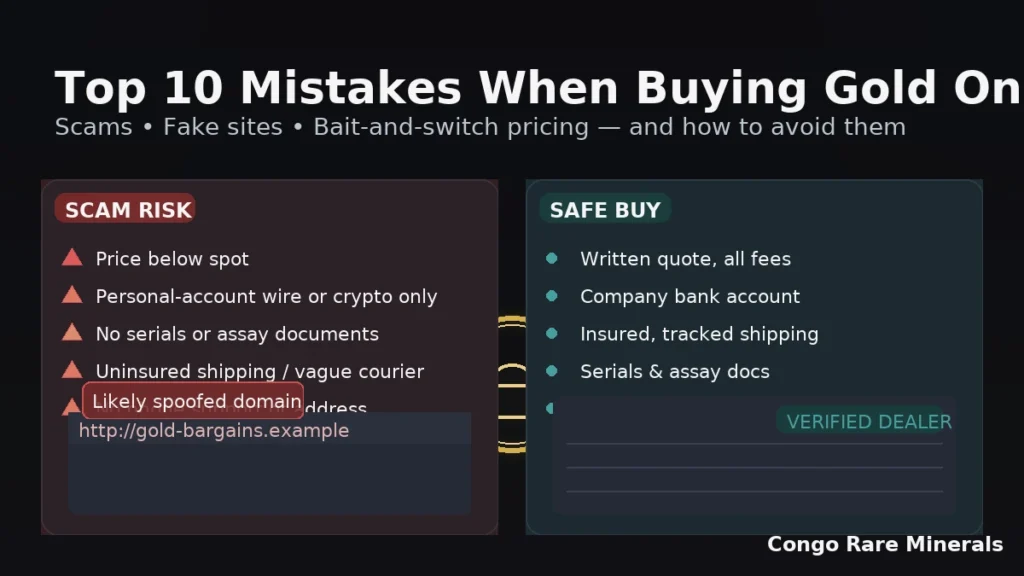Buying gold online should be simple. The trouble starts when prices look too good, websites look real but aren’t, or terms hide nasty fees. Use this guide to avoid the traps and buy with confidence.
1) Trusting a look-alike website
Scammers copy logos, fonts, and product pages.
Fix: Check the exact domain, company name, physical address, and a phone number that works. Read recent reviews from multiple sources. If support won’t speak on the phone, walk away.
2) Chasing prices that sit below spot
If the list price is below live spot or far under market premiums, it’s bait. You’ll face upsells or vanish-on-payment fraud.
Fix: Compare the total landed cost: item price + premium + shipping + insurance + taxes. If it looks unreal, it is.
3) Falling for bait-and-switch pricing
Some sites show a low “cash” price, then add surprise fees or pressure you into a different product at checkout.
Fix: Ask for a written quote that includes product, purity, weight, unit price, total, payment method, shipping, and insurance. No extras later.
4) Paying in ways you can’t reverse
Wires to personal accounts, crypto to unknown wallets, and gift cards are favorite scam rails.
Fix: Pay the business, not an individual. Use bank transfer to the company account or a card with buyer protections. For larger professional exports, use standard trade terms and insured couriers.
5) Skipping verification and documentation
No assay card, no serials, no bar list, no invoice details—that’s a hard pass.
Fix: Require a clean pack: invoice, assay report or card, serial-numbered bar list for cast bars, certificate of origin where applicable, insurance and airway bill for shipments. If you want independent testing, use Lab Testing and, if needed, third-party checks via Refining.
6) Buying odd sizes that are hard to resell
Random weights and obscure brands can be cheap today and expensive to sell later.
Fix: Stick to liquid units: 1 oz coins, 100 g, 250 g, and 1 kg bars. Ask dealers for their current buyback spread on each unit.
7) Ignoring the seller’s buyback and returns
Many sites sell but refuse to buy back or impose long delays.
Fix: Confirm buyback terms in writing: how they price, how they verify, and how quickly they pay. Keep every document.
8) Letting shipping and insurance become an afterthought
Uninsured or under-insured parcels are a silent risk.
Fix: Use tracked, fully insured shipping with tamper-evident packaging. Get the policy number. Inspect on arrival and film the unboxing for large orders.
9) Confusing collectibles with bullion
Numismatic coins carry big premiums and different risks.
Fix: If your goal is weight exposure, buy bullion. If you like collectibles, treat them as a separate hobby budget.
10) Assuming “no KYC” means easier and safer
Legitimate sellers follow compliance rules. If a site promises big orders with no paperwork, be careful.
Fix: Expect normal KYC for larger purchases and exports. Compliance protects both sides and speeds resale.
Fast red-flag checklist
| Red flag | What to do |
|---|---|
| Price below spot | Stop and verify the dealer |
| Wire to a personal name | Refuse and request company account |
| No live support | Don’t buy |
| “Cash price only” plus add-on fees | Demand a full written quote |
| No serials or assay | Ask for documentation or independent tests |
| Uninsured shipping | Upgrade or walk away |
How Congo Rare Minerals keeps this clean
- Clear, written quotes with all costs upfront.
- Standard units for liquidity: 1 oz, 100 g, 250 g, 1 kg.
- Verification support through Lab Testing and settlement options via Refining.
- Insured export and a tidy document pack for customs and future resale.
- Browse current products in the Shop or talk to sales on Contact.
FAQ
How do I spot a fake gold website quickly
Check the domain letter for letter, call the number, and ask for a sample invoice that shows serials and shipping insurance. Scammers avoid specifics.
Is it safe to pay with crypto for gold
Only if you already trust the counterparty and have written trade terms. For first-time orders, prefer a traceable company bank transfer or a card with protections.
What price checks should I do before buying
Confirm live spot, typical premiums for your unit size, and the total landed cost. Ask for the dealer’s current buyback spread on the same product.

